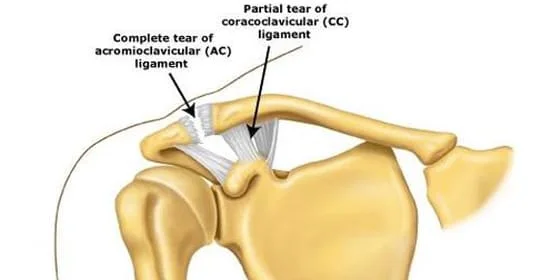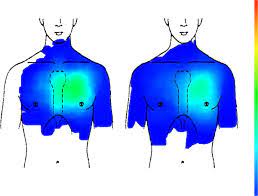Acromioclavicular (AC) Joint Sprain
An Acromioclavicular (AC) joint sprain is an injury that occurs when the ligaments connecting the acromion (a part of the shoulder blade) and the clavicle (collarbone) are stretched or torn due to a sudden impact or overuse.
This can cause pain, swelling, and limited shoulder movement. The severity of the sprain is categorized into different grades based on the extent of ligament damage and joint disruption.
Table of Contents
Causes of Acromioclavicular (AC) Joint Sprain
- Falls: Landing on an outstretched arm or directly on the shoulder can lead to a sprain of the AC joint.
- Sports Injuries: High-impact sports such as football, rugby, and skiing, where collisions or falls are common, can result in AC joint sprains.
- Accidents: Motor vehicle accidents and other traumatic incidents can lead to shoulder injuries, including AC joint sprains.
- Overuse: Repetitive strain from activities that involve lifting heavy weights or performing overhead movements can contribute to AC joint sprains over time.
- Work-related Activities: Jobs that require frequent lifting, carrying heavy loads, or repetitive shoulder movements can increase the risk of AC joint sprains.
- Contact Sports: Sports like hockey, wrestling, and martial arts, where physical contact is common, can lead to AC joint sprains due to collisions or direct impacts.
- Cycling Accidents: Falling off a bicycle or being involved in a cycling accident can result in shoulder injuries, including AC joint sprains.
- Lifting Heavy Objects: Improper lifting techniques or lifting objects that are too heavy can strain the AC joint and its surrounding structures.
- Improper Technique: Poor form while performing weightlifting exercises or other activities that involve shoulder movements can contribute to AC joint sprains.
- Sudden Movements: Abrupt movements that stress the shoulder joint, such as trying to catch yourself during a stumble, can lead to AC joint sprains.
- Aging and Degeneration: As individuals age, the ligaments and structures around the AC joint can become weaker and more prone to injury.
- Anatomical Factors: Some people may have certain anatomical variations that make their AC joint more susceptible to injury.
- Repetitive Strain: Engaging in repetitive activities with inadequate rest, like throwing a baseball or performing overhead work, can lead to overuse injuries, including AC joint sprains.
- Weak Muscles: Insufficient strength in the muscles around the shoulder can fail to provide proper stability, increasing the risk of AC joint sprains.
Symptoms of Acromioclavicular (AC) Joint Sprain
The symptoms of an acromioclavicular (AC) joint sprain can vary in intensity based on the severity of the injury. Common
symptoms include:
- Pain: Pain around the top of the shoulder or the AC joint is a primary symptom. The pain may be sharp or dull and can worsen with movement or when pressure is applied to the joint.
- Swelling: Swelling around the AC joint is common due to the inflammation caused by the injury.
- Tenderness: The area around the AC joint may feel tender to the touch.
- Limited Range of Motion: You may experience difficulty moving your arm and shoulder, especially when trying to lift the arm overhead or across the body.
- Bruising: Bruising may develop around the shoulder and upper arm due to internal bleeding from the injured ligaments.
- Visible Deformity: In more severe cases, the AC joint may become visibly displaced or distorted, leading to a noticeable deformity.
- Pain with Movement: Activities that involve moving the shoulder, such as reaching, lifting, or throwing, can trigger pain.
- Pain at Rest: Even when not actively using the shoulder, you might still experience discomfort or aching.
- Weakness: You may notice weakness in the shoulder and arm, especially when attempting to perform tasks that require strength.
- Popping or Clicking: Some individuals might hear or feel a popping or clicking sensation when moving the shoulder.
Risk factors
Several factors can increase the risk of experiencing an acromioclavicular (AC) joint sprain. These risk factors include:
- Participation in Contact Sports: Engaging in contact sports like football, rugby, and wrestling increases the risk of direct impacts on the shoulder, which can lead to AC joint sprains.
- High-Impact Activities: Activities that involve sudden and forceful movements, such as jumping, falling, or lifting heavy weights, raise the risk of injuring the AC joint.
- Poor Technique: Using improper form while lifting weights or performing shoulder-intensive exercises can stress the AC joint and its supporting structures.
- Previous Injuries: A history of shoulder injuries, including previous AC joint sprains, can weaken the joint and make it more susceptible to future injuries.
- Age: As individuals get older, the ligaments and tissues around the AC joint may naturally weaken, increasing the likelihood of sprains.
- Gender: Some studies suggest that males may have a higher risk of AC joint injuries due to differences in shoulder anatomy and muscle strength.
- Occupation: Jobs that involve repetitive overhead movements, heavy lifting, or frequent shoulder strain increase the risk of AC joint sprains.
- Anatomical Factors: Certain anatomical variations, such as having a smaller AC joint space or different bone structures, can contribute to an increased risk of injury.
- Inadequate Warm-Up: Not properly warming up before engaging in physical activities can lead to muscle imbalances and decreased joint stability, raising the risk of injury.
- Insufficient Strength and Conditioning: Weak shoulder muscles can fail to provide proper support to the AC joint, making it more susceptible to sprains.
- Overuse: Repeatedly stressing the AC joint without allowing adequate rest and recovery time can lead to overuse injuries.
Diagnosis
Diagnosing an acromioclavicular (AC) joint sprain typically involves a combination of medical evaluation, physical examination, and imaging tests.
- Medical History: Your doctor will begin by discussing your symptoms, the circumstances leading to the injury, and your medical history, including any previous shoulder injuries.
- Physical Examination: The doctor will examine your shoulder, assessing for tenderness, swelling, bruising, range of motion, and any visible deformities.
- Stress Tests: Special tests, such as the “cross-arm adduction” test or the “painful arc” test, may be performed to provoke specific movements and assess the AC joint’s stability and pain response.
- Imaging: Depending on the severity of the injury, your doctor might order imaging tests to confirm the diagnosis and assess the extent of damage. Common imaging methods include X-rays and magnetic resonance imaging (MRI).
- X-rays: X-rays can help rule out fractures and show the alignment of the bones around the AC joint.
- MRI: An MRI provides detailed images of soft tissues like ligaments, helping to evaluate the severity of ligament damage.
Grading: If a sprain is confirmed, the injury might be classified into different grades based on the severity of ligament involvement. Grades range from mild (Grade I) to severe (Grade III or higher) sprains.
- Differential Diagnosis: Your doctor might also consider other conditions that could present with similar symptoms, such as fractures, rotator cuff injuries, or other shoulder joint issues.
Medical Treatment of Acromioclavicular (AC) Joint Sprain
The medical treatment for an acromioclavicular (AC) joint sprain depends on the severity of the injury. Here are the possible approaches:
Conservative Treatment (Grade I and II Sprains):
- Rest and Activity Modification: Resting the affected shoulder and avoiding activities that worsen the pain can help the healing process.
- Ice: Applying ice to the area can reduce swelling and pain.
- Pain Management: Over-the-counter pain relievers or anti-inflammatory medications may be recommended to manage the reduce pain and inflammation.
- Physical Therapy: A physical therapist can guide you through exercises to improve your range of motion, strengthen supporting muscles, and aid in recovery.
- Supportive Measures: Wearing a sling or brace may help provide stability and reduce strain on the AC joint as it heals.
Medical Interventions:
- Corticosteroid Injections: In some cases, a corticosteroid injection might be considered to reduce inflammation and pain. However, these are typically reserved for cases that do not respond well to conservative treatment.
- Platelet-Rich Plasma (PRP) Therapy: This involves injecting your own platelet-rich plasma into the affected area to promote healing.
Physiotherapy Treatment
Physiotherapy plays a significant role in the treatment and recovery of an acromioclavicular (AC) joint sprain. A skilled physiotherapist can design a personalized treatment plan to help you regain strength, mobility, and function in your shoulder. Here’s what physiotherapy treatment for an AC joint sprain may involve:
- Initial Assessment: The physiotherapist will assess the severity of your injury, your range of motion, strength, and any compensatory movements you might be using to avoid pain.
- Pain Management: Techniques like ice, heat, ultrasound, or electrical stimulation might be used to help manage pain and reduce inflammation.
- Manual Therapy: The physiotherapist may use hands-on techniques to improve joint mobility, release muscle tension, and promote healing.
- Range of Motion Exercises: Gradual exercises will be introduced to help restore the full range of motion to your shoulder joint. These exercises are tailored to your condition and progress.
- Strengthening Exercises: Strengthening the muscles around the shoulder joint is essential for stability and support. The physiotherapist will guide you through exercises that target these muscles.
- Functional Exercises: As you progress, you’ll be guided through exercises that mimic real-life movements you’ll need to perform, helping you regain functional strength and coordination.
- Proprioception and Balance Training: These exercises improve your awareness of joint position and movement, helping to prevent future injuries.
- Bracing and Taping: The physiotherapist might teach you how to use supportive taping or bracing techniques to protect the AC joint during activities.
- Gradual Return to Activities: As you recover, your physiotherapist will guide you through a phased approach to returning to your regular activities and sports, ensuring you’re ready to handle the demands on your shoulders.
- Education and Home Exercises: You’ll receive guidance on proper body mechanics, posture, and exercises to continue at home to maintain your progress.
- Monitoring and Adjustments: Your treatment plan will be monitored and adjusted as needed based on your progress and any changes in your condition.
Exercise
Here are some exercises that may be included in a physiotherapy program for rehabilitating an acromioclavicular (AC) joint sprain. Keep in mind that the specific exercises and progression will depend on the severity of your injury, your pain level, and your therapist’s guidance. Always follow your therapist’s recommendations and consult a healthcare professional before starting any new exercise regimen:
Pendulum Exercises:
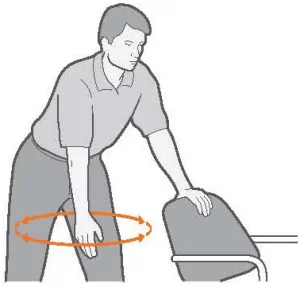
Gently swing your arm back and forth, side to side, and in circular motions to help improve your range of motion.
Passive Assisted Range of Motion:
Use your unaffected arm to gently assist your injured arm in performing controlled, pain-free movements.
Isometric Shoulder Exercises:
Contract your shoulder muscles without actually moving the joint. These exercises help maintain muscle activation without putting strain on the AC joint.
Scapular Squeezes:
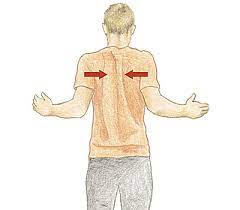
Squeeze your shoulder blades together to activate the muscles of the patient’s upper back.
Wall Climbing:
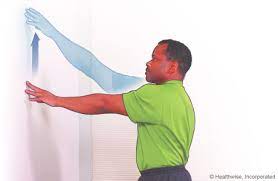
Stand facing a wall and “climb” your fingers up the wall as high as you can comfortably go. This exercise helps improve the overhead range of motion.
Shoulder Blade Retractions:
Sit or stand with good posture and retract your shoulder blades together, then relax. Repeat this motion.
Resisted Theraband Exercises:
Using a resistance band, perform exercises that involve controlled movements of the shoulder, such as shoulder flexion, abduction, and external rotation.
Rotator Cuff Strengthening:
Gradually incorporate exercises that target the rotator cuff muscles to improve shoulder stability.
External Rotation with Resistance Band:
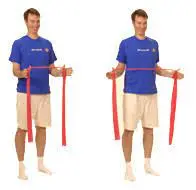
- Attach a resistance band to a stable object at waist height position.
- Stand sideways to the band’s anchor point with your elbow bent at 90 degrees and your forearm parallel to the floor.
- Keep your upper arm close to your body and rotate your forearm outward against the resistance of the band.
- Slowly back to the starting exercise position.
- Perform two to three sets of 10-15 repetitions on both arms.
Internal Rotation with Resistance Band:
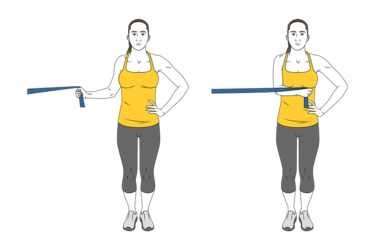
- Attach the resistance band at waist height on your opposite side.
- Stand sideways with the arm you’re exercising closest to the anchor point.
- Bend your elbow at 90 degrees and keep your forearm parallel to the floor.
- Keep your upper arm close to your body and rotate your forearm inward against the resistance of the band.
- Slowly back to the starting exercise position.
- Perform two to three sets of 10-15 repetitions on both arms.
Prone Row:
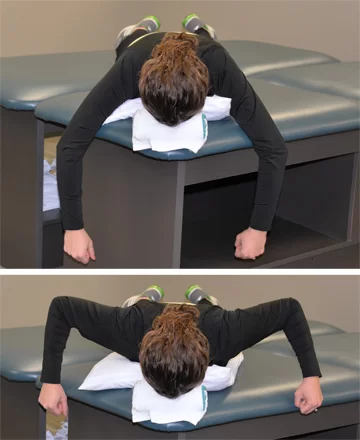
- Lie face down on an incline bench with a dumbbell in your hand.
- Allow your arm to hang down, then pull the dumbbell towards your hip, bending your elbow and squeezing your shoulder blade.
- Slowly lower the object back down.
- Do 2 to 3 sets of 10-15 repetitions on both arms.
Lawnmower Pull:
- Attach a resistance band to a sturdy object at waist height.
- Stand with your side facing the anchor point, holding the band handle in the hand farthest from the anchor.
- Imagine starting a lawnmower by pulling the band diagonally across your body, bending your elbow, and engaging your shoulder blade.
- Slowly release the band and return to the starting activity position.
- Perform two to three sets of 10-12 repetitions on both sides.
Y-Raise:
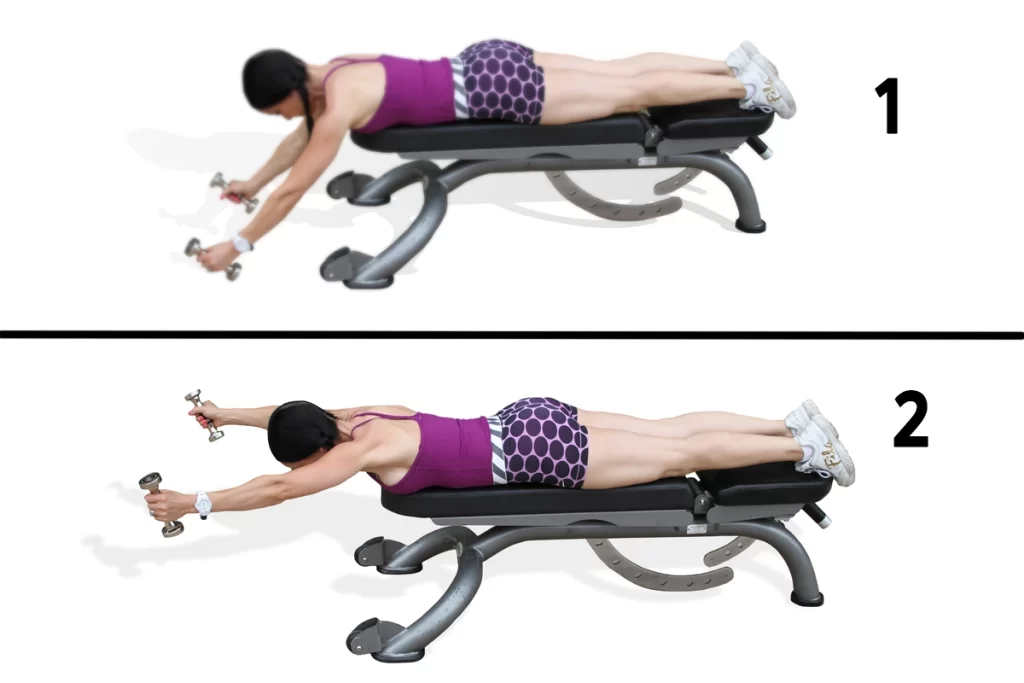
- Lie face down position on an incline bench with a light dumbbell in each hand.
- Hold the dumbbells with your palms facing each other and arms extended, forming a Y shape with your body.
- Lift the dumbbells upward, focusing on squeezing your shoulder blades together.
- Slowly lower the object back down.
- Perform two to three sets of 10-12 repetitions.
Scaption:
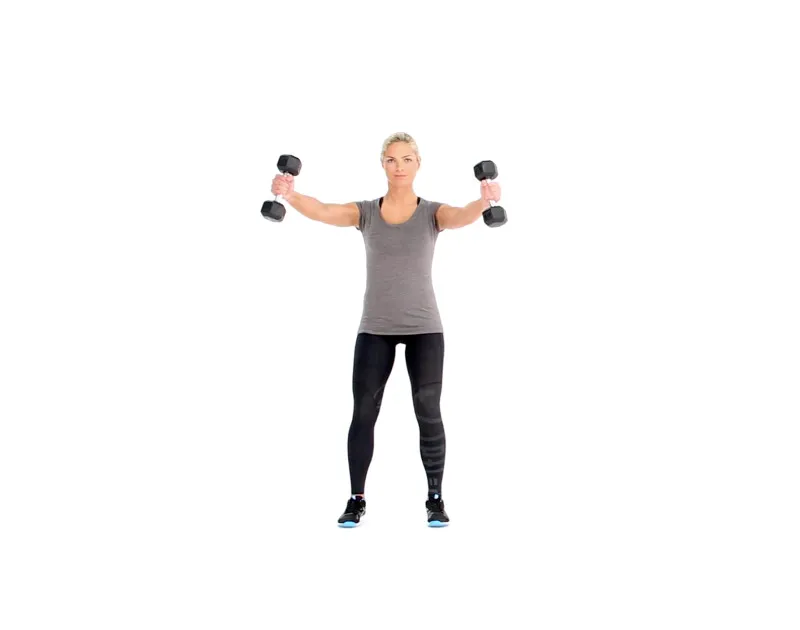
- Stand with a dumbbell in each hand and your arms by your sides, palms facing forward.
- Lift your arms diagonally forward and upward to shoulder level, keeping your thumbs pointed upward.
- Slowly lower the dumbbells back to the patient’s sides.
- Perform 2-3 sets of 10-12 repetitions.
Isometric Shoulder External Rotation:
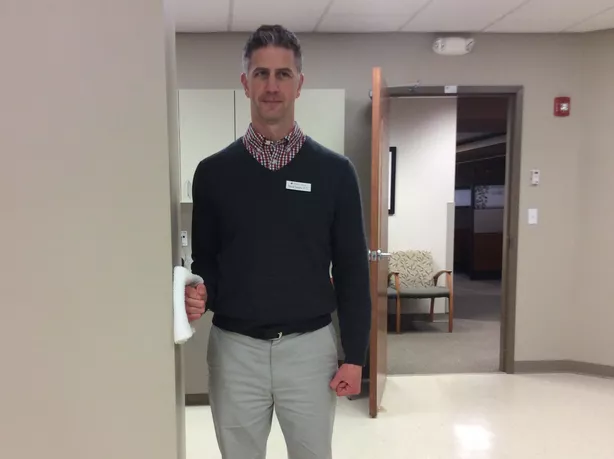
- Press your forearm against a wall or a sturdy surface, keeping your elbow bent at 90 degrees.
- Push outward against the surface, engaging the muscles around your AC joint.
- Hold for 5-10 seconds and release. Repeat 10 times.
Wall Angels:
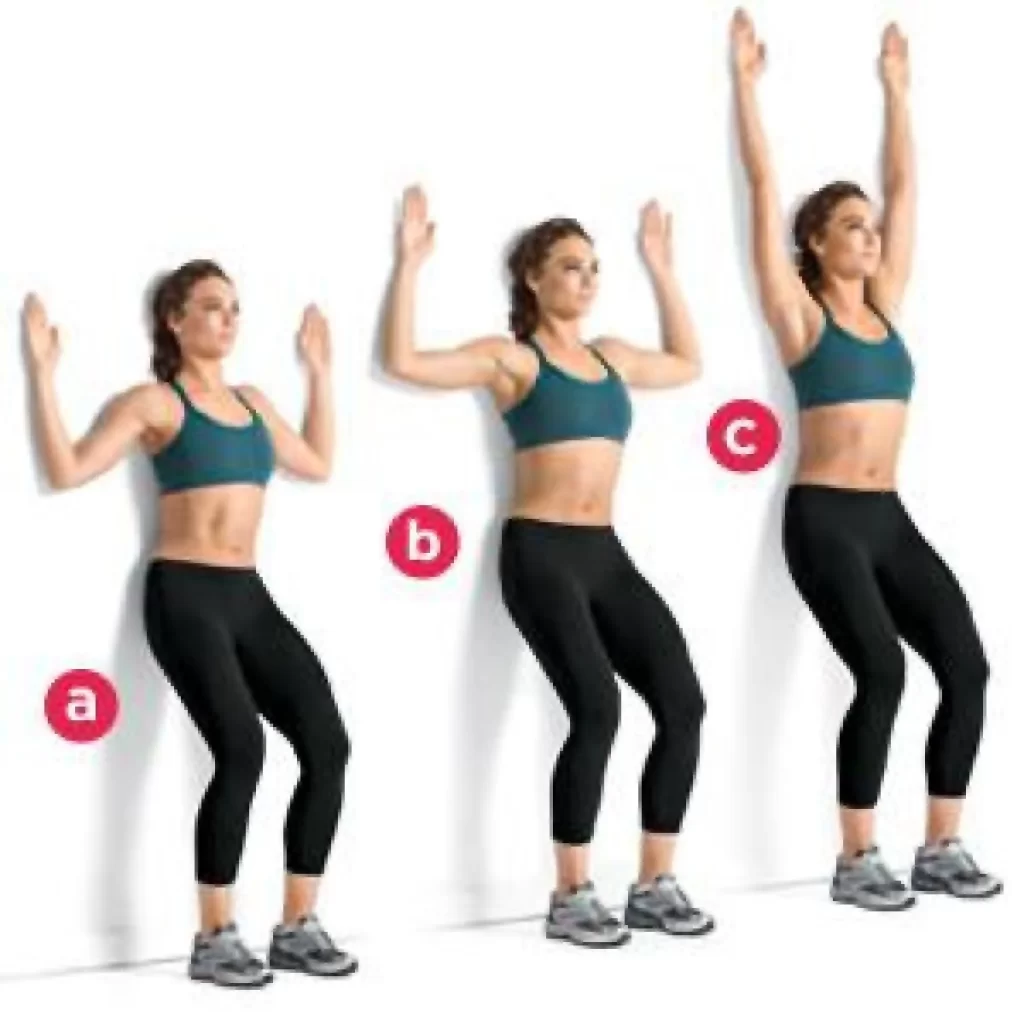
- Stand with your back against a wall and your arms bent at 90 degrees, forming a “W” shape.
- Slide your arms upward along the wall, maintaining contact at all times.
- Raise your arms as high as you can while keeping them in contact with the wall.
- Slowly return to the starting position. Repeat 10-15 times.
Eccentric Dumbbell Lowering:
- Hold a light dumbbell in the hand of your injured side.
- Use your unaffected arm to lift the dumbbell overhead.
- Slowly lower the dumbbell back to the starting position with your injured arm.
- Focus on controlling the movement during the lowering phase. Repeat 10-12 times.
Prone Shoulder Extension:
- Lie face down on a bench or a stability ball with a light dumbbell in each hand.
- Allow the patient’s arms to hang down toward the floor.
- Lift the dumbbells outward and upward, extending your arms backward.
- Lower the dumbbells back to the starting activity position. Repeat 10-12 times.
Scapular Push-Ups:
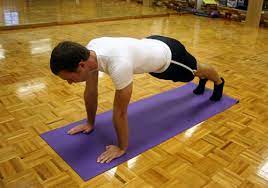
- Start in a push-up position, but with your elbows straight.
- Allow your shoulder blades to come together as you dip your chest towards the ground.
- Push your chest back up, protracting your shoulder blades. Repeat 10-15 times.
Bent-Over T’s and Y’s:
- Bend at the waist while holding a light dumbbell in each hand.
- For T’s, raise your arms straight out to the sides, forming a “T” shape.
- For Y’s, raise your arms diagonally forward and upward to form a “Y” shape.
- Focus on using your shoulder blades to initiate the movement. Repeat 10-12 times for each exercise.
Wall Stretch:
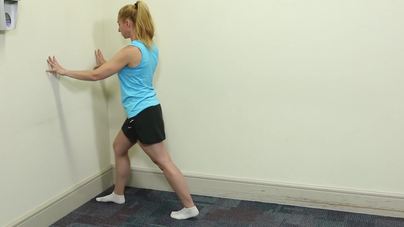
- Stand facing a wall with the patient’s fingertips touching the wall at shoulder height.
- Gently walk the patient’s fingers up the wall while keeping your body upright.
- Go as high as you can while maintaining good posture and without causing pain.
- Hold a stretch for a few seconds and repeat 10 times.
Shoulder Shrugs:
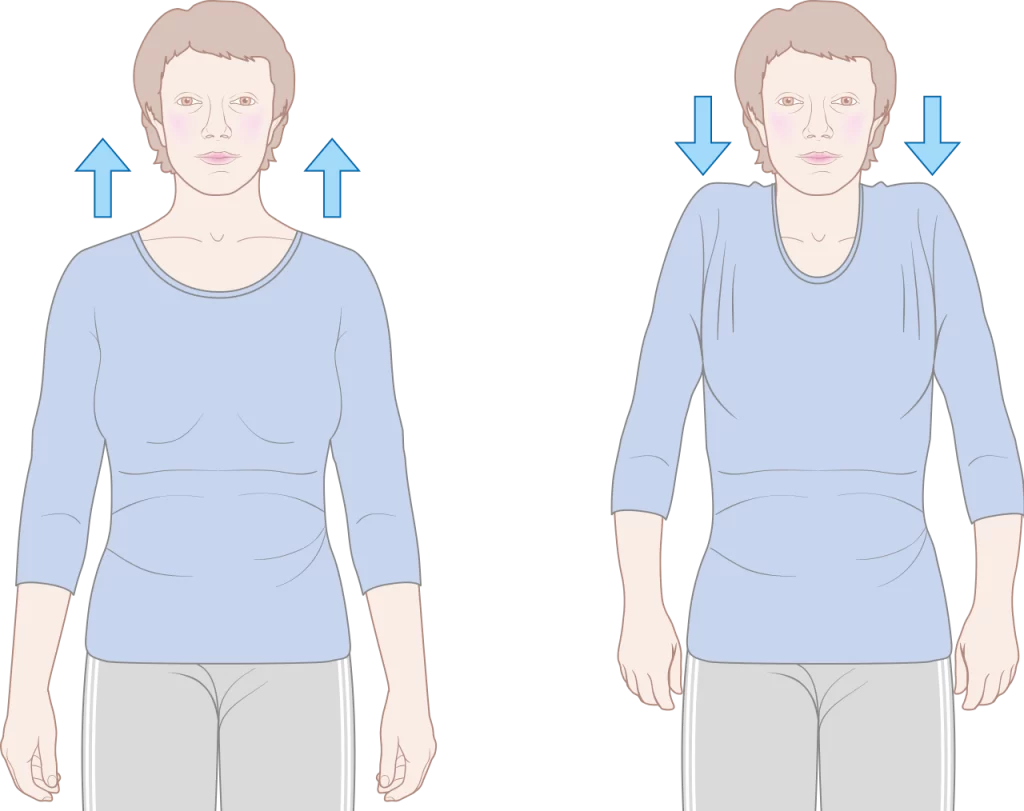
- Stand or sit with the patient’s arms relaxed at your sides.
- Shrug the patient’s shoulders up toward your ears, then relax them down.
- Perform 10-15 reps, focusing on controlled movement.
Prone “Y” Lifts:

- Lie face-down on a bench or exercise ball with a light dumbbell or any objects in each hand.
- Lift your arms forward and slightly outward, forming a “Y” shape, while squeezing your shoulder blades.
- Lower the dumbbells back down. Repeat 10-12 times.
Crossover Arm Stretch:
- Gently pull your injured arm across your body at chest level using your unaffected arm.
- Hold the stretch for a few seconds.
- Feel the stretch in the back of your shoulder and upper arm.
Standing Row with Resistance Band:
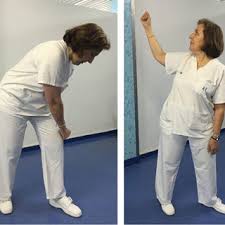
- Attach a resistance band to a doorknob or another anchor at waist height.
- Hold the band with the patient’s hands, palms facing each other.
- Pull the band towards the patient’s body while squeezing the patient’s shoulder blades together.
- Slowly release the band and return to the starting activity position. Repeat 10-12 times.
Closed Kinetic Chain Scapular Push-Ups:
- Place your hands against a wall at shoulder height and slightly wider than shoulder width apart.
- Lean into the wall, allowing your shoulder blades to come together.
- Push away from the wall, protracting your shoulder blades.
- Repeat 10-15 times.
Elevated Push-Ups:
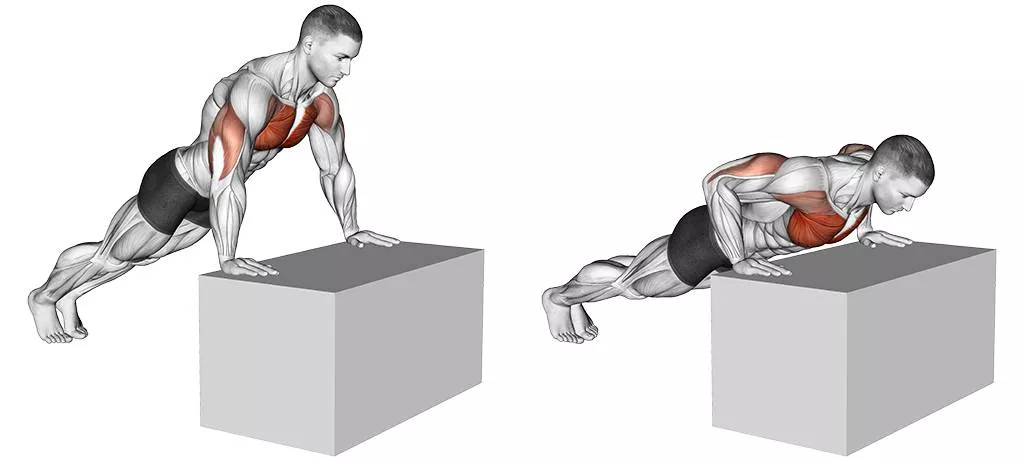
- Perform push-ups with your hands on an elevated surface, such as a bench or a step.
- This reduces the load on your shoulder joint while still engaging your chest and shoulder muscles.
- Start with a comfortable height and gradually progress as your strength improves.
Isometric Shoulder Elevation:
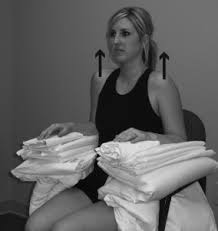
- Sit or stand position with good posture.
- Place the patient’s hands on your hips or against a wall.
- Gently push your hands upward against your hips or the wall, activating your shoulder muscles.
- Hold for 10-15 seconds, then release. Repeat 5-8 times.
Diagonal Shoulder Stretch:
- Stand with your injured arm crossed in front of your body at waist level.
- Use your unaffected hand to gently pull your injured arm across your body, feeling a stretch in your shoulder.
- Hold for a few seconds, then switch sides. Repeat 3 to 4 times shoulder stretch on both sides.
Wall Slide:
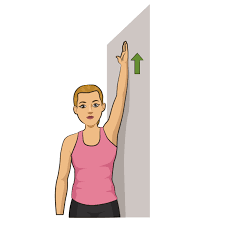
- Stand with your arms at your sides and your back against a wall.
- Slowly slide your arms up the wall, maintaining contact with your wrists, arms, and back.
- Reach as high as the patient can while keeping your shoulders relaxed. Then, slide your arms back down.
- Perform 10-12 repetitions.
Scapular Clockwork:
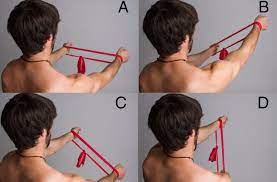
- Imagine a clock on the wall in front of you.
- Keeping your elbow bent at 90 degrees, move your hand in small clockwise circles, then counterclockwise circles.
- Focus on controlling the movement from your shoulder blade.
- Repeat for 10-12 circles in each direction.
Isometric Shoulder Retraction:
- Sit or stand position with good posture.
- Squeeze your shoulder blades together without moving your arms.
- Hold for 10-15 seconds, then release. Repeat 5-8 times.
Eccentric Push-Ups:
- Place your hands on an elevated surface, like a bench or a step, in a push-up position.
- Slowly lower your body down towards the surface, taking 3-5 seconds to lower yourself.
- Push back up to the starting activity position. Repeat 8-10 times.
Wall Angels with Resistance Band:
- Attach a resistance band at chest height.
- Stand facing the wall with the band in your hands, arms extended and palms facing the wall.
- Perform “snow angel” motions against the resistance of the band, focusing on controlled movement.
- Repeat 10-12 times.
Prone “T” Lifts:
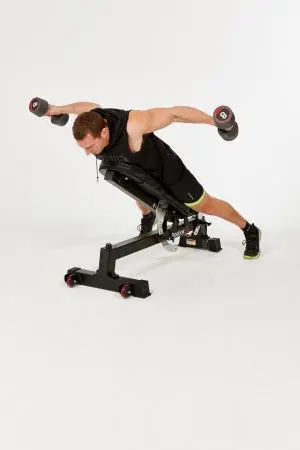
- Lie face-down position on a bench or exercise ball with a light dumbbell in each hand.
- Lift your arms out to the sides, forming a “T” shape, while squeezing your shoulder blades.
- Lower the dumbbells back down. Repeat 10-12 times.
Scapular Clockwise and Counterclockwise Wall Slide:

- Stand facing a wall with your arms raised to the shoulder level, palms against the wall.
- Keeping your arms straight, move your hands in small clockwise circles on the wall, then repeat in a counterclockwise direction.
- Perform 5-8 circles in all directions.
Dynamic Hug:
- Cross your arms in front of your body, hugging yourself.
- Slowly open your arms out to the sides while squeezing your shoulder blades together.
- Bring your arms back in front of your body and repeat 10-12 times.
Assisted Shoulder Flexion Stretch:
- Hold onto a sturdy object, such as a door frame or a wall, at waist height.
- Step forward with your injured side and gently lean into the stretch, feeling a gentle pull in your shoulder and chest.
- Hold for 15-30 seconds, then switch the other sides. Repeat 3 to 4 times stretch on each side.
Bent-Over “W” Lifts:
- Bend forward at the hips while holding a light dumbbell in both hands.
- Lift the patient’s arms out to the sides, forming a “W” shape, while keeping your shoulder blades squeezed together.
- Lower the dumbbells back down. Repeat 10-12 times.
Dynamic Scapular Protraction and Retraction:
- Start on your hands and knees with a slight arch in your back.
- Push your upper back up towards the ceiling, rounding your shoulders (protraction).
- Lower your chest down and pull your shoulder blades together (retraction).
- Repeat this dynamic movement for 10-12 reps.
Standing Shoulder Extension:
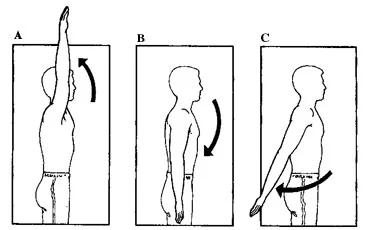
- Stand facing a wall with your palms against the wall at shoulder height.
- Lean forward slightly, allowing your shoulder blades to come together.
- Push the patient’s body back to the starting activity position. Repeat 10-15 times.
Surgery
Surgery for an acromioclavicular (AC) joint sprain is typically considered for more severe cases when conservative treatments have not provided adequate relief or when there is significant joint instability or deformity. The decision to undergo surgery is made in consultation with a medical professional, usually an orthopedic surgeon, who will evaluate your specific condition and medical history. Here’s an overview of what you might expect in terms of surgery for an AC joint sprain:
Surgical Options:
- Reconstruction: This involves repairing and stabilizing the damaged ligaments using sutures, anchors, or other devices. This can be done through an open incision or minimally invasive techniques.
- Ligament Transfer: In cases of severe AC joint instability, a nearby ligament (such as the coracoacromial ligament) might be repositioned to provide additional stability to the joint.
After undergoing surgery for an acromioclavicular (AC) joint sprain, the postoperative exercise and rehabilitation program will be tailored to your individual condition and the specific surgical procedure you had. It’s crucial to follow your surgeon’s and physiotherapist’s guidance closely to ensure a successful recovery.
Early Stage (Immediate Post-Surgery)
- Pain Management and Rest: Focus on managing pain and following your surgeon’s instructions for resting and immobilization.
- Gentle Range of Motion Exercises: Early on, your physiotherapist might guide you through gentle passive range of motion exercises to prevent stiffness and maintain joint mobility.
- Scapular Activation: Exercises to activate and strengthen the muscles around the shoulder blades can be initiated to promote stability and proper movement.
Intermediate Stage (2-6 Weeks Post-Surgery)
- Active Range of Motion: Begin with controlled active range of motion exercises, moving the shoulder within your comfort level and as directed by your physiotherapist.
- Isometric Exercises: Gradually introduce isometric exercises to engage the muscles without placing excessive stress on the healing structures.
- Scapular Stabilization: Continue with scapular stabilization exercises to enhance shoulder stability and support.
Advanced Stage (6-12 Weeks Post-Surgery)
- Resistance Band Exercises: Incorporate resistance band exercises to build strength and stability in a controlled manner.
- Closed Chain Exercises: Closed chain exercises, where your hand remains in contact with a surface (e.g., push-ups against a wall), can be introduced for safe strengthening.
- Functional Movements: Work on movements that mimic everyday activities and sports-specific motions under the guidance of your physiotherapist.
Late Stage (3 Months Post-Surgery and Beyond)
- Full Range of Motion: Strive to regain full range of motion in your shoulder while maintaining proper mechanics.
- Progressive Strengthening: Gradually increase the resistance and intensity of your exercises to continue building strength and stability.
- Sport-Specific Training: If you’re an athlete, your program might be tailored to your sport’s demands as you approach a return to full activity.
Prevention
Preventing an acromioclavicular (AC) joint sprain involves a combination of strategies to promote shoulder health, improve muscle strength, and minimize the risk of injury. Here are some tips for prevention:
- Proper Technique and Form: Use correct techniques when lifting weights, performing overhead movements, and participating in sports. Avoid putting the shoulder joint under too much stress.
- Gradual Progression: Gradually increase the intensity and duration of your workouts to give your shoulder muscles and ligaments time to adapt.
- Warm-Up and Cool-Down: Always warm up your muscles with gentle exercises before engaging in intense activities. Cool down and stretch after workouts.
- Shoulder Strengthening: Include exercises that target the rotator cuff muscles and muscles that stabilize the shoulder blade.
- Core Strengthening: A strong core helps improve overall posture and stability, which can reduce stress on the shoulder joint.
- Balanced Workouts: Avoid overtraining certain muscle groups. Maintain a balanced exercise routine that addresses all muscle groups.
- Flexibility and Mobility: Incorporate stretches that improve shoulder flexibility and mobility.
- Proper Equipment: Use appropriate sports equipment, such as protective gear and well-fitted shoulder pads, when engaging in contact sports.
- Rest and Recovery: Your body requires enough rest time to recover between workouts. Listen to the patient’s body and avoid pushing through aches.
- Posture Awareness: Maintain good posture throughout the day to avoid unnecessary stress on the shoulders.
- Avoid Overhead Strain: Be cautious when lifting heavy objects overhead, especially if you’re not used to such activities.
- Cross-Training: Engage in a variety of activities to prevent overuse injuries and promote well-rounded fitness.
- Hydration and Nutrition: Stay hydrated and maintain a balanced diet to support overall musculoskeletal health.
- Regular Check-Ups: Schedule regular visits with a healthcare professional to monitor your shoulder health and address any issues early.
- Proper Rest: Get adequate sleep to support muscle recovery and overall health.
- Injury Management: If you experience any shoulder discomfort or pain, address it promptly and follow recommended treatments to prevent the worsening of the condition.
Complications
While many acromioclavicular (AC) joint sprains heal with proper treatment and rehabilitation, there can be potential complications or factors that may affect the recovery process. Here are some complications and considerations to be aware of:
- Incomplete Healing: In some cases, the injured ligaments might not heal fully, leading to ongoing instability and chronic pain in the shoulder joint.
- Persistent Instability: Despite conservative treatment or surgery, the joint might remain unstable, limiting your ability to perform certain activities.
- Stiffness: Inactivity during the healing process can lead to stiffness in the shoulder joint. This can affect a range of motion and function.
- Frozen Shoulder (Adhesive Capsulitis): Prolonged immobility or inadequate rehabilitation can lead to the development of a frozen shoulder, characterized by severe stiffness and limited movement.
- Nerve or Blood Vessel Injury: Surgical procedures carry a risk of damaging nearby nerves or blood vessels, potentially leading to sensory changes, numbness, or weakness.
- Infection: An infection could occur during any kind of surgical surgery. Proper wound treatment and adherence to postoperative instructions are crucial to minimize this risk of infection.
- Scar Tissue Formation: After surgery, scar tissue may form around the surgical site, potentially affecting shoulder mobility and function.
- Recurrent Injury: If the underlying causes of the initial AC joint sprain, such as poor technique or muscle imbalances, are not addressed, there’s a risk of recurrent injuries.
- Chronic Pain: In some cases, chronic pain might persist even after adequate healing due to factors such as nerve irritation or ongoing joint stress.
- Postoperative Complications: Surgical procedures come with their own set of risks, including infection, blood clots, adverse reactions to anesthesia, and healing complications.
- Limited Function: In more severe cases, despite treatment, the AC joint might not fully regain its pre-injury function, leading to limitations in certain activities.
- Follow Medical Advice: Adhere to the treatment plan outlined by your healthcare provider or surgeon, including postoperative instructions.
- Participate in Rehabilitation: Engage in rehabilitation exercises as prescribed by your physiotherapist to regain strength, mobility, and stability.
- Avoid Overexertion: Gradually progress your activities, avoiding overexertion that might lead to re-injury.
- Maintain Good Posture: Practice proper posture to reduce stress on the shoulder joint and surrounding muscles.
- Communicate with Healthcare Professionals: If you experience unexpected symptoms, pain, or changes in your condition, promptly communicate with your healthcare provider.
Home Advice
Certainly, here’s some home advice to help you manage and recover from an acromioclavicular (AC) joint sprain:
- Rest: Give your injured shoulder time to heal by avoiding activities that cause pain or strain. Rest is important for the initial stages of recovery.
- Ice: Apply ice to the injured area for 15-20 minutes every 2-3 hours during the first 48 hours. Use a cloth or towel to protect the patient’s skin from direct contact with the ice.
- Pain Management: Over-the-counter pain relievers or anti-inflammatory medications (if appropriate for you) can help manage pain and reduce inflammation. Follow the recommended dosages.
- Immobilization: If advised by your healthcare provider, use a sling or brace to stabilize the shoulder and prevent unnecessary movement.
- Elevation: When resting, keep your injured arm elevated to help reduce swelling.
- Gentle Movement: As directed by your healthcare provider or physiotherapist, perform a gentle range of motion exercises to prevent stiffness. Do not force movements that cause aches.
- Healthy Diet: Maintain a balanced diet rich in nutrients to support healing and overall health.
- Hydration: Drink plenty of water to stay hydrated, which supports tissue healing and recovery.
- Sleep Position: Sleep on your back or on the uninjured side to avoid putting pressure on the injured shoulder.
- Avoid Heavy Lifting: Refrain from lifting heavy objects or engaging in activities that strain the injured shoulder.
- Avoid Overhead Activities: Steer clear of overhead activities or movements that exacerbate pain.
- Heat Therapy: After the initial acute phase, you might use heat therapy to relax muscles and improve circulation. Apply a warm compress for 15-20 minutes at a time.
- Stay Active Safely: Engage in gentle activities that do not stress the injured area, such as walking. Consult your healthcare provider before resuming more intense exercises.
- Proper Posture: Maintain good posture to prevent unnecessary strain on your shoulders and neck.
- Communication: Regularly update your healthcare provider or physiotherapist on your progress and any changes in your condition.
- Follow Medical Advice: Adhere to the treatment plan provided by your healthcare provider, including any recommended exercises or follow-up appointments.
- Patience: Recovery takes time. Be patient and avoid rushing back into activities before you’re fully healed.
FAQ
What is an AC joint sprain?
An AC joint sprain is an injury to the ligaments that connect the acromion (part of the shoulder blade) and the clavicle (collarbone). It’s commonly caused by a fall on the shoulder or a direct blow to the area.
What are the common symptoms of an AC joint sprain?
Symptoms include pain over the AC joint, swelling, tenderness, limited range of motion, and possible deformity if the injury is severe.
How is an AC joint sprain diagnosed?
Diagnosis is typically based on a physical examination, medical history, and possibly imaging tests such as X-rays or MRI to assess the severity of the injury.
What’s the recovery time for an AC joint sprain?
Recovery time varies depending on the severity of the AC joint injury. Mild cases might recover in a few weeks, while more severe cases could take several weeks to months.
How can I manage pain from an AC joint sprain?
Using ice, over-the-counter pain relievers, and following your healthcare provider’s recommendations can help manage pain.

